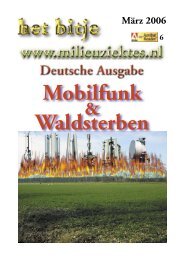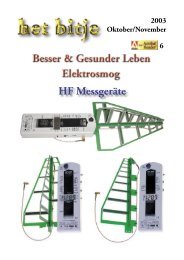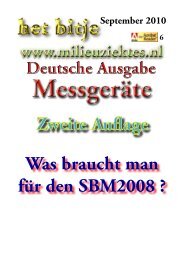You also want an ePaper? Increase the reach of your titles
YUMPU automatically turns print PDFs into web optimized ePapers that Google loves.
<strong>August</strong> <strong>2006</strong><br />
6
2<br />
Content and Colodings Charles Claessens page 2<br />
Microwave Warner Charles Claessens page 3<br />
Colofon <strong>het</strong> <strong>bitje</strong> Charles Claessens page 7<br />
Here the answer to the question, posed on the frontpage:<br />
What is the finger pointing at?<br />
Again a new meter, which already was mentioned in the May issue.<br />
Now it is here.<br />
On the following pages, it is described.<br />
Although a certain German manufacturer of measurement meters announced in 2004 , that<br />
all the manufacturers of broadband meters would be *out of business*, because he had developed<br />
a *Supermeter*, he himself announced on 31-03-<strong>2006</strong> also a brand new broadband<br />
meter, with extended frequency range. Obviously because the Spektrumanalysator does not<br />
seem to be *das gelbe vom Ei*.<br />
Presumably it will be available in October. And yes, this year.<br />
It is much later than first thought to be.<br />
But that happens to everybody. Everybody experiences delays.<br />
Gigahertz Solutions brings in September the HFW35C .<br />
The HF-Analyser HFW35C will be available in two types.<br />
One type has only the basic functions, the other is with all “chicaneries ”.<br />
Important: The frequency range of both types starts there, where the momentary types stop,<br />
so they are an addition, not a replacement.<br />
The fundamentals of the basic meter is according to the „normal“ HF35C, but the most<br />
dominant frequencies of GSM mobile phone, and DECT will be suppressed by more than<br />
40 dB. With that a genuine analysis of the range from 2,4 till over 6 GHz possible (f.i. Bluetooth<br />
wireless applications / PC-networks, WIMAX, some radar frequencies and the upper<br />
WLAN-band / “WiFi”).<br />
To that belongs also the upcoming DECT 2 with 5.8 GHz.<br />
ROM Elektronik will present in September the new HFR-4.<br />
It should be able to measure from 1 MHz up to 10 GHz .<br />
Unfortunately the frequencybandfilter, like with the HFA-3, will not be incorporated.<br />
<strong>August</strong> <strong>2006</strong><br />
So, the broadband measuring devices are still going strong, and new things are being developed<br />
permanently.
3<br />
Endotronic now has finished the Microwave Warner.<br />
Because of the many tests and calibrations, it took a while longer than expected, but now it<br />
is here. A bit larger than a package of matches.<br />
There are now 4 LED's. When switched on, with the switch on the right (see following page)<br />
the left LED blinks every second as a sign that the device is on.<br />
On the lower surface is a switch for switching the peeper on- or off.<br />
<strong>August</strong> <strong>2006</strong><br />
The next three LED's do show, if high frequent radiation is present.<br />
10, 100 or 1.000 µW/m². When radiation is detected, the bleeper starts.<br />
One should hold the device with the thumb on the spot marked *hold here*, so that the upper<br />
side, where the antenna is placed, can search properly.<br />
The cord is only there in order to prevent losing the device.<br />
A recommended place to store it is a shirt-pocket, in which the device is placed with the<br />
control side to the body and with the clamp attached to the edge of the pocket.
<strong>August</strong> <strong>2006</strong><br />
4
5<br />
The device is delivered in a leather pouch, with a manual and loading trafo accordingly the<br />
built-in accu.<br />
Dimensions: 50 x 70 x 20mm.<br />
Weight: 70 gram.<br />
According circumstances the following microwave disturbers are being detected and measured<br />
at the following distances:<br />
Mobile phone, connecting 80-100 m<br />
Microwave oven<br />
40 m<br />
DECT telephone<br />
6-8 m<br />
Electr. Babysitter<br />
5-6 m<br />
Bluetooth-WLAN<br />
10-50 m<br />
Mobile phone mast<br />
200-400 m<br />
Airway radar<br />
some km<br />
UMTS<br />
ca. 400 m<br />
<strong>August</strong> <strong>2006</strong><br />
So, the first, green, lightdiode blinks every second, to announce that the device is working<br />
and is checking and controlling the surroundings for technical microwaves in the frequency<br />
range of ca. 400 MHz to 3,5 GHz, up to 24 hours with only one accucharge.<br />
As Guinea pig I used a DECT phone.<br />
The second lightdiode, yellow, blinks at ca. 10 µW/m² (Salzburger guide line)<br />
I checked and found 120-200 µW/m² (with HF58B and HFA-3).<br />
The third lightdiode, red, blinks at ca. 100 µW/m² (old Salzburger guide line).
In praxis happened that with me at about 200-300 µW/m².<br />
6<br />
The fourth lightdiode, also red, blinks at ca. 1.000 µW/m² (sugg. guide line Ecolog-Study).<br />
With me, this was at ca. 1.700 µW/m².<br />
But one should realise, that ALL meters do have deviations. Also the most expensive Spectrumanalysers<br />
do have a tolerance of ca. ± 3 dB. In Switzerland there is a discussion going on<br />
about the *not measurable* UMTS signals, where meters of ca. 25.000 € a tolerance show of<br />
a factor 4.3 in V/m or 18,5 in mW/m².<br />
So, the deviations of the Microwave Warner are tolerant and acceptable.<br />
Pinpointing of interference sources is also possible. The device should be held with the thumb<br />
on the marked place *Hold here*, and the upper edge should never be covered.<br />
When peep + yellow LED do show present microwaves, they can be pinpointed very easily.<br />
One should hold the device a bit tilted in front of the chest at about 20 cm distance, and turn<br />
your body slowly around your axis. The LED scale shows, from where the strongest signals<br />
are coming, and opposite the own body shields off.<br />
When one moves into the direction of the pinpointed source, the amount of signals gets<br />
higher, and one may see the source eventually, for instance a mobile phone mast antenna.<br />
With every on- and off switching process of electrical energy, sparks develop with a broadband<br />
interference spectrum, so also microwaves, which are shown by the Microwave Warner, when<br />
they are not technically screened, like with piezo ignitions of gas stoves, light switches and<br />
switches which are used by electrical apparatus. The intensity of the disturbance is dependant<br />
of the switched capacity. Screened apparatus, where the screensafety is distorted, can be detected<br />
by the Microwave Warner as continuous malfunction.<br />
Especially remarkably, because the Microwave Warner, holds the detected signals a bit longer<br />
in its memory, in order to give the LED's the necessary time for lighting.<br />
With a light switch very easy to observe.<br />
The Microwave Warner is a real warning device (Indicator), which should help, to expose the<br />
immediate surroundings, to avoid them, to dismantle, f.i. how strong the leaking radiation of<br />
a microwave oven runs through the house, mobile phones, DECT-phones, etc.<br />
Teachers may check in the classroom w<strong>het</strong>her mobiles are used.<br />
And everybody has a quick survey of every situation.<br />
<strong>August</strong> <strong>2006</strong><br />
Obtainable with:<br />
Endotronic GmbH<br />
Rosenhalde 8<br />
D- 88260 Argenbühl<br />
Tel.: 07566-465<br />
and with:<br />
PSE- Priggen Special Electronic<br />
Sellen 102a<br />
D- 48565 Steinfurt/ Germany<br />
Tel: 02551-5770<br />
www.priggen.com<br />
Priggen@t-online.de
7<br />
Eindredactie:<br />
Ontwerp en vormgeving:<br />
Charles Claessens<br />
Charles Claessens<br />
Redactie:<br />
Charles Claessens info@<strong>het</strong><strong>bitje</strong>.nl tel 0032-14-388632<br />
Kopij altijd welkom !<br />
Copyright:<br />
Het auteursrecht van de artikelen berust nadrukkelijk bij de auteurs. Overname van gehele of<br />
gedeelten van artikelen is alleen toegestaan na nadrukkelijke toestemming van de auteur en<br />
mits de bron, *<strong>het</strong> <strong>bitje</strong>* wordt vermeld.<br />
Ingezonden kopij:<br />
De redactie van *<strong>het</strong> <strong>bitje</strong>* is niet verantwoordelijk voor de auteursrechten of <strong>het</strong> copyright<br />
van de ingezonden kopij. De verantwoordelijkheid en aansprakelijkheid ligt bij de inzender.<br />
De redactie behoudt zich <strong>het</strong> recht voor om, in overleg, ingezonden kopij in te korten, in<br />
meerdere afleveringen of in anderszins gewijzigde vorm te plaatsen.<br />
*<strong>het</strong> <strong>bitje</strong>* zal de 1e van iedere maand te downloaden zijn van de webpagina:<br />
http://www.<strong>het</strong><strong>bitje</strong>.nl<br />
evenals op:<br />
http://www.milieuziektes.nl<br />
Voor die wijsneuzen, die willen weten waarmee <strong>het</strong> <strong>bitje</strong> tot stand is gekomen:<br />
InDesign CS, Acrobat 6.0, Photoshop CS, Paint Shop Pro 9, XaraX 1.0,<br />
Painter IX, KPT 5, S-Spline 2.2 en veel fantasie [1938 was toch wel een goed jaar].<br />
<strong>August</strong> <strong>2006</strong><br />
Het is ook mogelijk <strong>het</strong> <strong>bitje</strong> bij verschijnen automatisch per e-mail<br />
in uw postbak te ontvangen.<br />
U dient dit dan wel via een e-mail kenbaar te maken aan:<br />
info@<strong>het</strong><strong>bitje</strong>.nl<br />
Als u <strong>het</strong> met bepaalde artikelen niet eens bent, mag u uw mening best aan de redaktie mededelen.<br />
Dan hebben we meteen weer kopij voor <strong>het</strong> volgende nummer!











